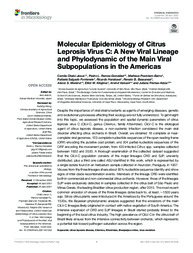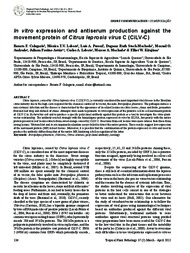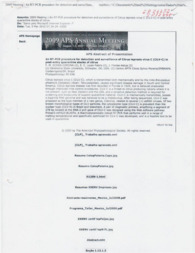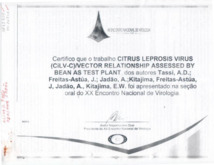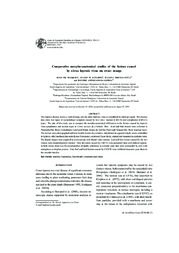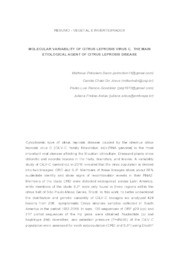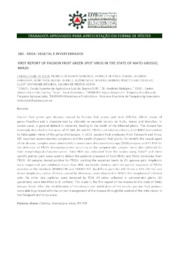Search Publications
Filter by:
| Author(s): CHABI-JESUS, C.; RAMOS-GONZÁLEZ, P. L.; POSTCLAM-BARRO, M.; FONTENELE, RA. S.; HARAKAVA, R.; BASSANEZI, R. B.; MOREIRA, A. S.; KITAJIMA, E. W.; VARSANI, A.; ASTUA, J. de F. Despite the importance of viral strains/variants as agents of emerging diseases, genetic and evolutionary processes affecting their ecology are not fully understood. To get insight into this topic, we... ... |
| Author(s): BASSANEZI, R. B.; CZERMAINSKI, A. B. C.; BARBOSA, F. F. L.; MOREIRA, A. S.; RIBEIRO JUNIOR, P. J.; KRAINSKI, E. T.; AMORIM, L. Leprosis is caused by the Citrus leprosis virus cytoplasmic type and is vectored by the mite Brevipalpus yothersi. Miticide applications, which cost $54 million annually, are based on inspection for t... ... |
| Author(s): CALEGARIO, R. F.; LABATE, M. T. V.; PERONI, LUÍS A.; STACH-MACHADO, D. R.; ASTUA, J. de F.; LABATE, C. A.; MACHADO, M. A.; KITAJIMA, E. W. Citrus leprosis, caused by Citrus leprosis virus C (CiLV-C), is currently considered the most important viral disease in the Brazilian citrus industry due to the high costs required for the chemical c... ... |
| Author(s): OCHOA-CORONA, F. M.; LOCALI-FABRIS, E. C.; FREITAS-ASTÚA, J. Citrus leprosis virus C (CiLV-C), which is transmitted both mechanically and by the mite Brevipalpus phoenicis (Geijskes) (Acari: Tenuipalpidae), causes significant disease damage in South and Central... ... |
| Author(s): TASSI, A. D.; FREITAS-ASTÚA, J.; JADÃO, A.; KITAJIMA, E. W. The study of the virus/vector relationship in the citrus leprosis pathosystem has been hampered by the fact that the development of the lesions after the inoculation of the virus by Brevipalpus phoeni... ... |
| Author(s): MARQUES, J. P. R.; KITAJIMA, E. W.; FREITAS-ASTUA, J.; APPEZZATO-DA-GLORIA, B. The leprosis disease shows a viral etiology and the citrus leprosis virus is considered its etiologic agent. The disease may show two types of cytopatologic symptom caused by two virus: nuclear (CiLV-... ... |
| Author(s): BARRO, M. P.; JESUS, C. C. DE; RAMOS-GONZÁLEZ, P. L.; ASTUA, J. de F. Cytoplasmic type of citrus leprosis disease caused by the cilevirus citrus leprosis virus C [CiLV-C; family Kitaviridae; ss(+)RNA genome] is the most important viral disease affecting the Brazilian ci... ... |
| Author(s): SINICO, T. E.; ARENA, G. D.; KITAJIMA, E. W.; MACHADO, M. A.; NOVELLI, V. M.; ASTUA, J. de F.
|
| Author(s): CHABI-JESUS, C.; RAMOS-GONZÁLEZ, P. L.; TASSI, A. D.; PEREIRA, L. R.; BASTIANEL, M.; LAU, D.; CANALE, M. C.; HARAKAVA, R.; NOVELLI, V. M.; KITAJIMA, E. W. N.; ASTUA, J. de F. Citrus leprosis (CL) is the main viral disease affecting the Brazilian citriculture. Sweet orange (Citrus sinensis L. Osbeck) trees affected by CL were identified in small orchards in Southern Brazil.... ... |
| Author(s): ARENA, G. D.; RAMOS-GONZÁLEZ, P. L.; ROGERIO, L. A.; FALK, B. W.; CASTEEL, C. L.; MACHADO, M. A.; ASTUA, J. de F. Citrus leprosis virus C (CiLV-C, genus Cilevirus, family Kitaviridae) is the prevalent causal agent of citrus leprosis, the main viral disease affecting citrus groves in Brazil. [...]. |
Observation
Some of Embrapa's publications are published as ePub files. To read them, use or download one of the following free software options to your computer or mobile device. Android: Google Play Books; IOS: iBooks; Windows and Linux: Calibre.
Access other publications
Access the Agricultural Research Database (BDPA) to consult Embrapa's full library collection and records.
Visit Embrapa Bookstore to purchase books and other publications sold by Embrapa.

